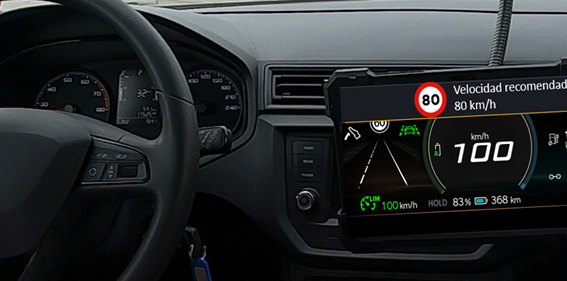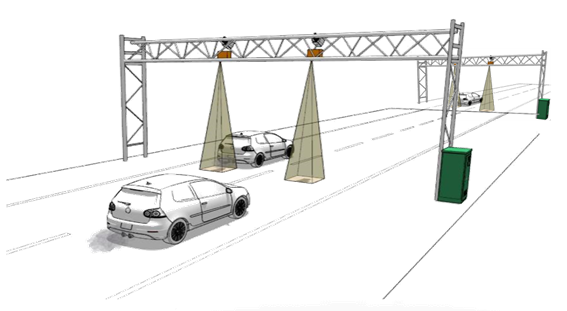Trends
Trends
OCT
07
2025
5G
Driving while polluting less… and paying less
We live in an increasingly connected world. Mobile phones, homes, offices and factories already rely on constant connectivity. Roads can also benefit: a strong digital infrastructure allows cars to receive real-time information, reduce congestion, improve safety and make driving more sustainable. In the near future, even autonomous vehicles will depend on smart roads that can “talk” to them.
How will it work? Let’s take an example we have all experienced: a never-ending traffic jam, cars stopped under the sun, polluted air and frayed nerves behind the wheel. Every minute means wasted time, money and health. Now imagine the road itself helping you avoid this situation, advising you on the right speed to keep traffic flowing and reduce pollution. Or tolls that adjust dynamically, rewarding those driving cleaner vehicles.
Beyond saving time and money, reducing pollution in these situations has a direct impact on people’s health: fewer harmful particles in the air mean fewer respiratory diseases, less stress while driving and a better quality of life for everyone.
The magic of connectivity
Behind this innovation is the ability of cars and infrastructure to communicate, known as C-V2X (Cellular Vehicle-to-Everything). Thanks to this technology and 5G Standalone networks, vehicles can “talk” to the road instantly.
This is where infrastructure operators like Cellnex play a decisive role: deploying the systems that make this conversation between cars and roads possible.
The term V2X (Vehicle-to-Everything) refers to the ability of vehicles to communicate in real time with everything around them: other cars, traffic signs, traffic lights, information panels, and even pedestrians’ mobile phones.
To make this possible, the following technology infrastructure is needed:
- Road Side Units (RSU): small devices installed on gantries, signs or lampposts that send and receive traffic information.
- On Board Units (OBU): systems that allow vehicles to receive and process these signals.
- 5G networks and low-latency servers: ensuring that information is transmitted and processed almost in real time.
In practice, this means that if a car suddenly brakes or a sensor detects high pollution levels, the signal reaches other vehicles in milliseconds. Or the road can recommend the optimal speed for smoother, less polluting traffic.
“Thanks to V2X, roads cease to be passive spaces and become smart infrastructures, able to anticipate problems and improve both safety and sustainability,” says Javier Santaella, Innovation Project Manager at Cellnex.
A laboratory on the C-32
The C-32 motorway, between Calafell and Gavà, has become a pioneering space where this new mobility model is being tested. Here, technology allows drivers to receive personalized speed recommendations either on their mobile phones or on roadside panels. Following them not only makes traffic flow more smoothly: it can also reduce vehicle emissions by up to 30%.
A dynamic toll has also been implemented, adjusting prices based on two factors:
- Traffic intensity.
- Real emissions from each vehicle, measured in real time by roadside sensors.
In other words, responsible drivers – those who pollute less and help keep traffic flowing – pay less.

Early data from this testbed point to very concrete benefits:
- Identification of heavy polluters: only 2% of vehicles generate extremely high emissions. Identifying and acting on them can significantly improve air quality.
- Smoother traffic: harmonizing average speeds reduces congestion and fuel consumption.
- Greater road safety: roads can send immediate alerts to drivers if a risk is detected.
A vision of the future
Imagine entering a city where your car automatically adapts to its surroundings, tolls adjust to your driving behavior and roads guide you to avoid risks.
What is being tested in Barcelona today could be extended to any European city tomorrow. In fact, the European Commission has already established that all countries must measure real vehicle emissions on the road to identify heavy polluters.
This is the essence of CRETA, a European project that seeks to turn our roads into allies of the environment and road safety.
According to Javier Santaella: “CRETA is not just an innovation project: it is a roadmap towards the future of mobility. Cleaner, safer and fairer roads for everyone.”
What is the CRETA project?
CRETA (Traffic Emission Reduction and Control) is a Spanish innovation initiative funded with €2.7 million, supported by the European Union through the NextGenerationEU funds (Recovery, Transformation and Resilience Plan, UNICO-5G Sectorial program).
The project includes three pilots in Spain:
- Barcelona: interurban mobility with dynamic tolling based on real vehicle emissions.
- Madrid: access control in Low Emission Zones and advanced traffic monitoring.
- Irún/Gipuzkoa: cross-border management of heavy traffic, identification of polluting vehicles and control of illegal manipulations.
In all these cases, CRETA combines 5G, remote emission measurement and artificial intelligence algorithms to move towards more efficient and fair mobility.
The consortium consists of eight partners: Grupo MASMOVIL, Cellnex (through its subsidiary Tradia), Abertis Mobility Services, Autopistas, INDRA, OPUS RSE, Alpha Syltec Ingeniería and Vinces Consulting. Each contributes a key component: from connectivity and C-V2X deployment, to emissions measurement, smart tolling, artificial intelligence and infrastructure operation.
Cellnex has played a key role in the deployment of C-V2X technology within the project. “The C-V2X deployment we have implemented at Cellnex is essential to advancing connected vehicle technology,” says Santaella. He adds: “CRETA not only transforms roads: it transforms the way we move, live and care for the planet.”

















